大学英语课程说课
- 格式:ppt
- 大小:412.50 KB
- 文档页数:2
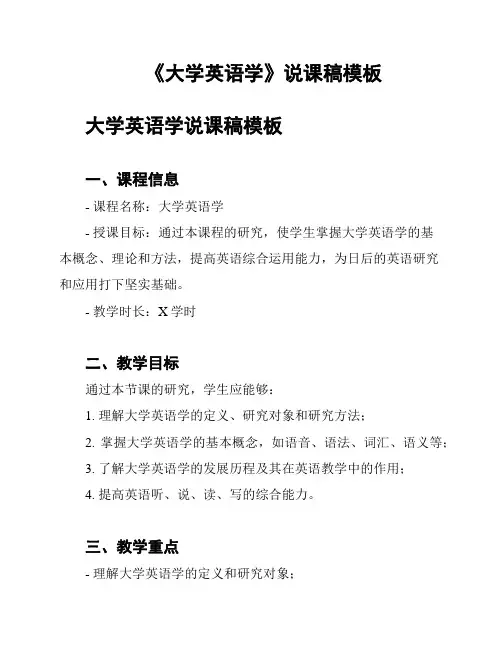
《大学英语学》说课稿模板大学英语学说课稿模板一、课程信息- 课程名称:大学英语学- 授课目标:通过本课程的研究,使学生掌握大学英语学的基本概念、理论和方法,提高英语综合运用能力,为日后的英语研究和应用打下坚实基础。
- 教学时长:X学时二、教学目标通过本节课的研究,学生应能够:1. 理解大学英语学的定义、研究对象和研究方法;2. 掌握大学英语学的基本概念,如语音、语法、词汇、语义等;3. 了解大学英语学的发展历程及其在英语教学中的作用;4. 提高英语听、说、读、写的综合能力。
三、教学重点- 理解大学英语学的定义和研究对象;- 掌握大学英语学的基本概念;- 理解大学英语学在英语教学中的作用。
四、教学内容与安排1. 大学英语学的定义(5分钟)- 介绍大学英语学的含义和研究对象;- 引导学生思考大学英语学的研究方法和意义。
2. 大学英语学的基本概念(15分钟)- 分别介绍语音学、语法学、词汇学、语义学等基本概念;- 通过示例和练巩固学生的理解。
3. 大学英语学的发展历程与作用(10分钟)- 介绍大学英语学的发展历程,从传统语法教学到交际教学的转变;- 引导学生讨论大学英语学在英语教学中的作用和意义。
4. 英语听说读写综合能力的提高(20分钟)- 设计听力练,培养学生的听力理解能力;- 组织口语练,提高学生的口语表达能力;- 分析、阅读和写作练,提升学生的阅读和写作能力。
五、教学方法与手段- 多媒体教学:通过幻灯片、视频等多媒体资料展示相关内容;- 分组讨论:鼓励学生在小组内讨论和交流,促进思维碰撞;- 问题解答:引导学生提出问题,并给予答疑解惑;- 视听训练:提供相关听力材料和口语练,锻炼学生的听说能力;- 书面练:布置阅读和写作练,提高学生的阅读和写作水平。
六、教学评价与反馈- 教学评价方法:考试、作业、小组讨论、课堂表现等;- 教学反馈方式:及时批改作业、回答学生提问、评价学生的课堂表现等。
七、教学资源- 幻灯片:提供相关知识和案例分析的幻灯片资料;- 多媒体设备:确保教学过程中的多媒体展示效果;- 研究资料:提供相关教材、阅读材料和练题。
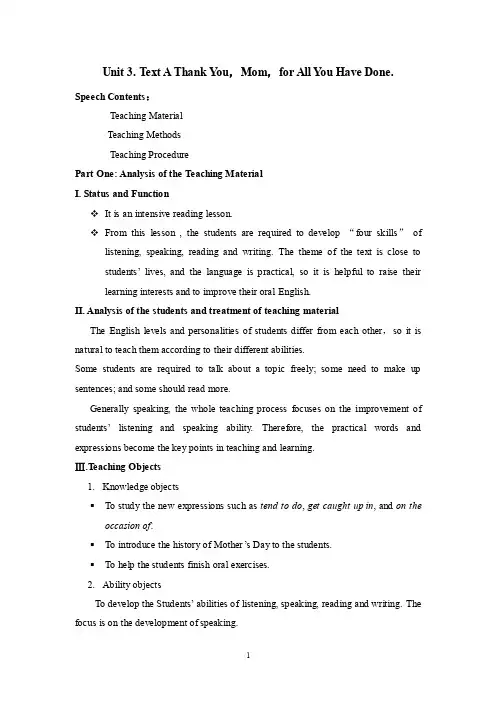
Unit 3. T ext A Thank Y ou,Mom,for All Y ou Have Done. Speech Contents:Teaching MaterialTeaching MethodsTeaching ProcedurePart One: Analysis of the Teaching MaterialI. Status and FunctionIt is an intensive reading lesson.From this lesson , the students are required to develop “four skills”of listening, speaking, reading and writing. The theme of the text is close to students’lives, and the language is practical, so it is helpful to raise their learning interests and to improve their oral English.II. Analysis of the students and treatment of teaching materialThe English levels and personalities of students differ from each other,so it is natural to teach them according to their different abilities.Some students are required to talk about a topic freely; some need to make up sentences; and some should read more.Generally speaking, the whole teaching process focuses on the improvement of student s’listening and speaking ability. Therefore, the practical words and expressions become the key points in teaching and learning.Ⅲ.T eaching Objects1.Knowledge objects▪To study the new expressions such as tend to do, get caught up in, and on the occasion of.▪To introduce the history of Mother’s Day to the students.▪To help the students finish oral exercises.2.Ability objectsTo develop the Students’ abilities of listening, speaking, reading and writing. The focus is on the development of speaking.3.Moral objectsTo enable the students to realize more about how great mothers’love is, and are willing to take the time to care for their mothers after learning.Ⅳ. T eaching PointsKey points:1. the usages of language points of this part.2. oral practice in the class.3. the structure of a private letterDifficult points:1.To develop the students’interest in English.2.To make the students understand the theme of the text deeply.Ⅴ.T eaching AidsMulti-media computer ;OHP (over head projector) ;Software: PPTPart Two: Teaching MethodsAsking questions & Interacting with studentsShowing picturesOral practicePart Three: Teaching ProcedureI. Lead-in:★Question:What is the most precious and everlasting thing in the world?★Picture Discussion.II. Detailed AnalysisKey words and expressions:get caught up intend to doIt’s none of your businesstake the time to do sth. & spend time doing sth.on the occasion ofIII. Background KnowledgeIt’s necessary for students to improve their culture quality when they are mainly working on listening and speaking English. In this way, the proper background information is introduced.1. The history of Mother’ s Day2. The English expressions of some other festivalsIV. Writing Part: Review the Structure of a Private Letter.Even if the improvement of students’ writing ability isn’t put into the first place, it can not be neglected. This part helps the students’ to review the general structure of writing a private letter. It will be helpful to prepare for the study next time.V. Assignment:Due to the special form of this text, it’s necessary for the students to preview the rest part of the text--- the letter. And detailed study of writing a private letter will be carry out next period.。
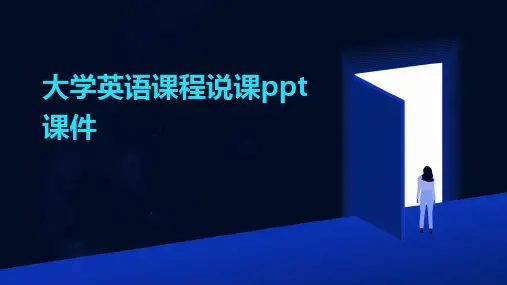

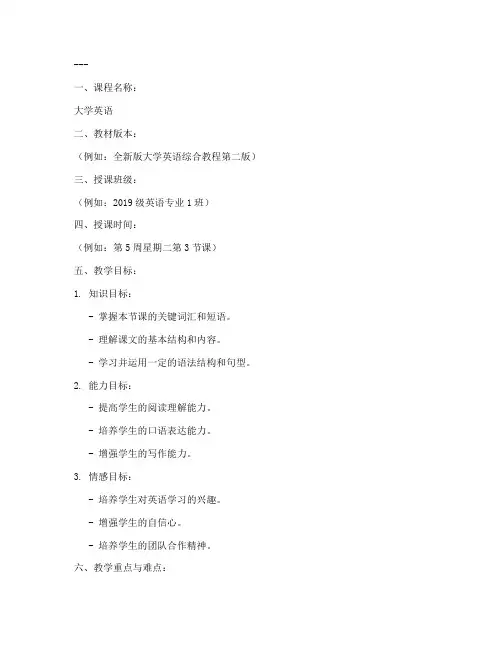
---一、课程名称:大学英语二、教材版本:(例如:全新版大学英语综合教程第二版)三、授课班级:(例如:2019级英语专业1班)四、授课时间:(例如:第5周星期二第3节课)五、教学目标:1. 知识目标:- 掌握本节课的关键词汇和短语。
- 理解课文的基本结构和内容。
- 学习并运用一定的语法结构和句型。
2. 能力目标:- 提高学生的阅读理解能力。
- 培养学生的口语表达能力。
- 增强学生的写作能力。
3. 情感目标:- 培养学生对英语学习的兴趣。
- 增强学生的自信心。
- 培养学生的团队合作精神。
六、教学重点与难点:1. 教学重点:- 课文中的核心词汇和短语。
- 课文的主旨大意。
- 课文中的语法结构和句型。
2. 教学难点:- 复杂的语法结构。
- 课文的深层含义。
- 阅读和写作的技巧。
七、教学方法:1. 讲授法:针对教学重点,教师进行系统的讲解。
2. 讨论法:鼓励学生积极参与课堂讨论,发表自己的看法。
3. 练习法:通过大量的练习,巩固所学知识。
4. 多媒体辅助教学法:利用PPT、视频等多媒体手段,提高教学效果。
八、教学过程:1. 导入(5分钟):- 教师简要介绍本节课的主题和内容。
- 引导学生回顾上节课所学知识。
2. 新课导入(10分钟):- 阅读课文,了解课文大意。
- 教师讲解课文中的关键词汇和短语。
3. 讨论与练习(20分钟):- 学生分组讨论课文内容,分享自己的观点。
- 教师布置相关练习,巩固所学知识。
4. 语法讲解(10分钟):- 教师讲解课文中的语法结构和句型。
5. 写作指导(10分钟):- 教师指导学生如何根据课文内容进行写作。
6. 课堂小结(5分钟):- 教师总结本节课的重点内容。
- 学生提出疑问,教师解答。
7. 作业布置(5分钟):- 布置课后作业,巩固所学知识。
九、板书设计:1. 课文标题2. 关键词汇和短语3. 语法结构和句型4. 写作要点十、教学反思:1. 教学过程中,是否达到了教学目标?2. 学生的学习效果如何?3. 教学方法是否合适?4. 课后如何改进教学?---本模板仅供参考,具体内容需根据实际情况进行调整。
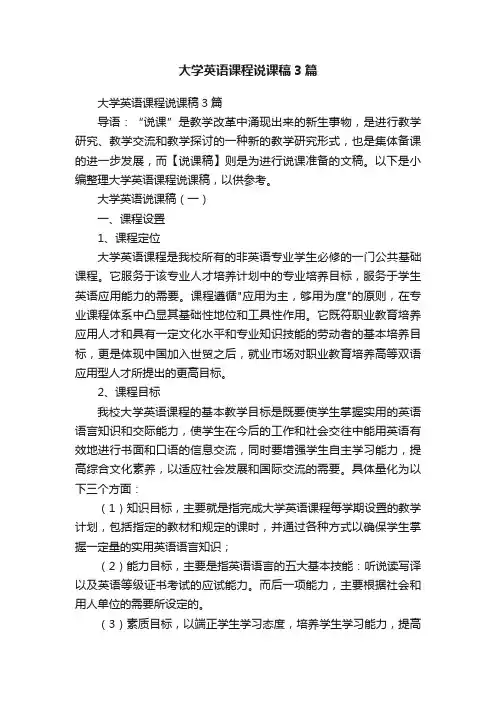
大学英语课程说课稿3篇大学英语课程说课稿3篇导语:“说课”是教学改革中涌现出来的新生事物,是进行教学研究、教学交流和教学探讨的一种新的教学研究形式,也是集体备课的进一步发展,而【说课稿】则是为进行说课准备的文稿。
以下是小编整理大学英语课程说课稿,以供参考。
大学英语说课稿(一)一、课程设置1、课程定位大学英语课程是我校所有的非英语专业学生必修的一门公共基础课程。
它服务于该专业人才培养计划中的专业培养目标,服务于学生英语应用能力的需要。
课程遵循"应用为主,够用为度"的原则,在专业课程体系中凸显其基础性地位和工具性作用。
它既符职业教育培养应用人才和具有一定文化水平和专业知识技能的劳动者的基本培养目标,更是体现中国加入世贸之后,就业市场对职业教育培养高等双语应用型人才所提出的更高目标。
2、课程目标我校大学英语课程的基本教学目标是既要使学生掌握实用的英语语言知识和交际能力,使学生在今后的工作和社会交往中能用英语有效地进行书面和口语的信息交流,同时要增强学生自主学习能力,提高综合文化素养,以适应社会发展和国际交流的需要。
具体量化为以下三个方面:(1)知识目标,主要就是指完成大学英语课程每学期设置的教学计划,包括指定的教材和规定的课时,并通过各种方式以确保学生掌握一定量的实用英语语言知识;(2)能力目标,主要是指英语语言的五大基本技能:听说读写译以及英语等级证书考试的应试能力。
而后一项能力,主要根据社会和用人单位的需要所设定的。
(3)素质目标,以端正学生学习态度,培养学生学习能力,提高学生综合素质为内容的一项认知性目标。
3、课程设计我们在课程设计上主要体现三个结合:首先,课堂教学与课外学习相结合,在抓好课堂教学的同时,充分发挥开展课外教学活动的优势。
其次,基础教学与等级考试相结合,为了增加学生就业时的竞争力,将课程安排与等级考试同步进行。
最后,基础英语与行业英语相结合,课程实施注重工学结合,将基础英语与行业英语结合。
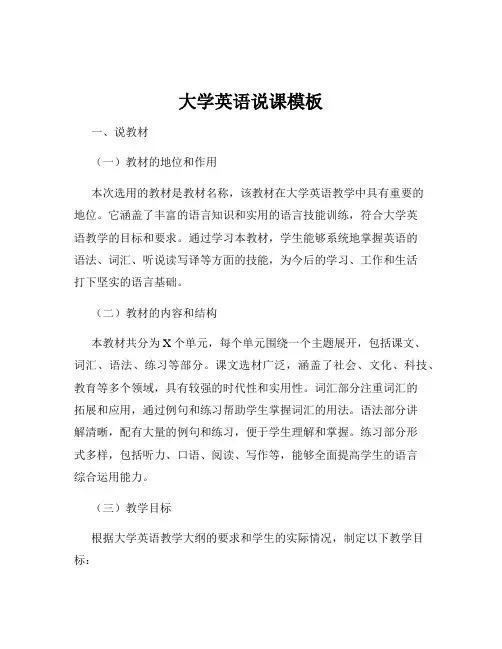
大学英语说课模板一、说教材(一)教材的地位和作用本次选用的教材是教材名称,该教材在大学英语教学中具有重要的地位。
它涵盖了丰富的语言知识和实用的语言技能训练,符合大学英语教学的目标和要求。
通过学习本教材,学生能够系统地掌握英语的语法、词汇、听说读写译等方面的技能,为今后的学习、工作和生活打下坚实的语言基础。
(二)教材的内容和结构本教材共分为X个单元,每个单元围绕一个主题展开,包括课文、词汇、语法、练习等部分。
课文选材广泛,涵盖了社会、文化、科技、教育等多个领域,具有较强的时代性和实用性。
词汇部分注重词汇的拓展和应用,通过例句和练习帮助学生掌握词汇的用法。
语法部分讲解清晰,配有大量的例句和练习,便于学生理解和掌握。
练习部分形式多样,包括听力、口语、阅读、写作等,能够全面提高学生的语言综合运用能力。
(三)教学目标根据大学英语教学大纲的要求和学生的实际情况,制定以下教学目标:1、知识目标掌握教材中的重点词汇和短语,能够正确运用。
掌握教材中的重点语法结构,能够熟练运用。
理解课文的内容和主旨,能够回答相关问题。
2、技能目标能够听懂与课文主题相关的英语材料,理解主要内容。
能够用英语进行简单的日常交流,表达自己的观点和想法。
能够阅读与课文难度相当的英语文章,获取主要信息。
能够用英语写一篇与课文主题相关的短文,表达自己的观点和看法。
3、情感目标激发学生学习英语的兴趣,培养学生的学习积极性和主动性。
培养学生的跨文化交际意识,提高学生的文化素养。
培养学生的团队合作精神和自主学习能力。
(四)教学重难点1、教学重点重点词汇和短语的用法,如列举重点词汇和短语。
重点语法结构的运用,如列举重点语法结构。
课文的理解和掌握,包括课文的主旨、细节和语言特点。
2、教学难点某些复杂语法结构的理解和运用,如列举复杂语法结构。
如何引导学生用英语进行有效的交流和表达。
如何培养学生的自主学习能力和跨文化交际意识。
二、说教法(一)教学方法的选择为了实现教学目标,突破教学重难点,在教学过程中采用了多种教学方法,如讲授法、讨论法、练习法、情景教学法等。
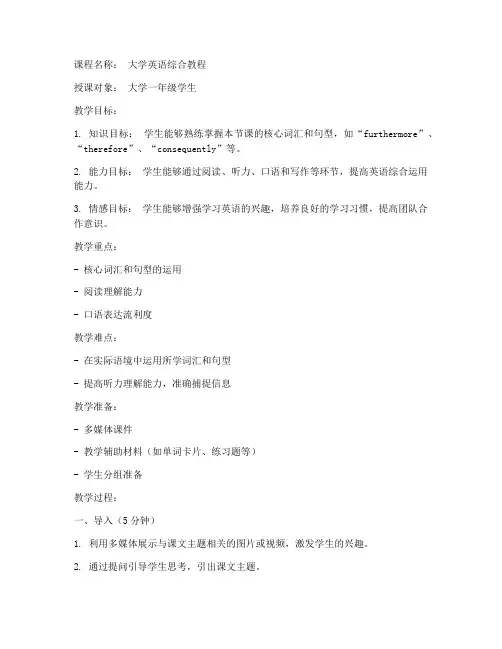
课程名称:大学英语综合教程授课对象:大学一年级学生教学目标:1. 知识目标:学生能够熟练掌握本节课的核心词汇和句型,如“furthermore”、“therefore”、“consequently”等。
2. 能力目标:学生能够通过阅读、听力、口语和写作等环节,提高英语综合运用能力。
3. 情感目标:学生能够增强学习英语的兴趣,培养良好的学习习惯,提高团队合作意识。
教学重点:- 核心词汇和句型的运用- 阅读理解能力- 口语表达流利度教学难点:- 在实际语境中运用所学词汇和句型- 提高听力理解能力,准确捕捉信息教学准备:- 多媒体课件- 教学辅助材料(如单词卡片、练习题等)- 学生分组准备教学过程:一、导入(5分钟)1. 利用多媒体展示与课文主题相关的图片或视频,激发学生的兴趣。
2. 通过提问引导学生思考,引出课文主题。
二、阅读理解(15分钟)1. 学生阅读课文,了解文章大意。
2. 教师提问,检查学生对文章内容的理解。
3. 学生小组讨论,深入分析文章结构和语言特点。
三、词汇学习(10分钟)1. 教师讲解课文中的核心词汇和句型,并举例说明其用法。
2. 学生跟读并模仿,加强记忆。
3. 学生完成词汇练习题,巩固所学知识。
四、听力训练(10分钟)1. 学生听课文录音,注意捕捉关键信息。
2. 教师提问,检查学生对听力材料的理解。
3. 学生复述听力内容,提高口语表达能力。
五、口语练习(10分钟)1. 学生分组进行角色扮演,模拟课文中的场景。
2. 教师巡回指导,纠正发音和语法错误。
3. 学生展示练习成果,互相评价。
六、写作训练(10分钟)1. 教师给出写作题目,学生进行写作练习。
2. 学生展示写作成果,教师点评并给予修改建议。
七、总结与作业布置(5分钟)1. 教师对本节课进行总结,强调重点内容。
2. 布置课后作业,巩固所学知识。
教学反思:- 教师在教学过程中要注意关注学生的学习情况,及时调整教学策略。
- 鼓励学生积极参与课堂活动,提高学习兴趣。
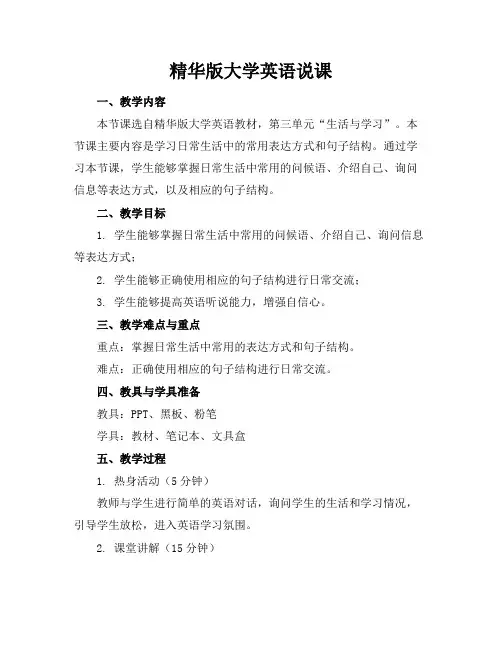
精华版大学英语说课一、教学内容本节课选自精华版大学英语教材,第三单元“生活与学习”。
本节课主要内容是学习日常生活中的常用表达方式和句子结构。
通过学习本节课,学生能够掌握日常生活中常用的问候语、介绍自己、询问信息等表达方式,以及相应的句子结构。
二、教学目标1. 学生能够掌握日常生活中常用的问候语、介绍自己、询问信息等表达方式;2. 学生能够正确使用相应的句子结构进行日常交流;3. 学生能够提高英语听说能力,增强自信心。
三、教学难点与重点重点:掌握日常生活中常用的表达方式和句子结构。
难点:正确使用相应的句子结构进行日常交流。
四、教具与学具准备教具:PPT、黑板、粉笔学具:教材、笔记本、文具盒五、教学过程1. 热身活动(5分钟)教师与学生进行简单的英语对话,询问学生的生活和学习情况,引导学生放松,进入英语学习氛围。
2. 课堂讲解(15分钟)教师通过PPT展示本节课的主要内容,讲解日常生活中常用的表达方式和句子结构,引导学生进行学习和实践。
3. 实例讲解(10分钟)教师通过实例讲解,让学生更好地理解和学习本节课的内容。
例如,教师可以模拟一个日常生活中的场景,如在食堂、商场等地方进行交流,让学生观看并模仿。
4. 小组讨论(5分钟)学生分组进行讨论,练习使用本节课学到的表达方式和句子结构进行日常交流。
教师可以巡回指导,纠正学生的错误,并给予鼓励。
六、板书设计板书内容包括本节课的主要表达方式和句子结构,如问候语、介绍自己、询问信息等。
板书设计要求简洁明了,便于学生理解和记忆。
七、作业设计1. 作业题目:请用英语写一篇关于你自己的介绍,包括你的姓名、年龄、爱好、学习情况等。
答案:Hello, my name is Li Ming. I am 18 years old. My hobbies are playing basketball and listening to music. I am a student of Computer Science.2. 作业题目:请用英语写一段对话,内容包括询问一个朋友的生日和礼物。
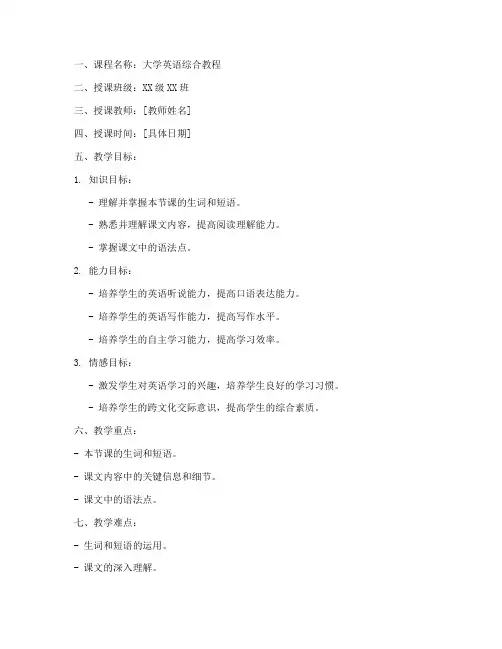
一、课程名称:大学英语综合教程二、授课班级:XX级XX班三、授课教师:[教师姓名]四、授课时间:[具体日期]五、教学目标:1. 知识目标:- 理解并掌握本节课的生词和短语。
- 熟悉并理解课文内容,提高阅读理解能力。
- 掌握课文中的语法点。
2. 能力目标:- 培养学生的英语听说能力,提高口语表达能力。
- 培养学生的英语写作能力,提高写作水平。
- 培养学生的自主学习能力,提高学习效率。
3. 情感目标:- 激发学生对英语学习的兴趣,培养学生良好的学习习惯。
- 培养学生的跨文化交际意识,提高学生的综合素质。
六、教学重点:- 本节课的生词和短语。
- 课文内容中的关键信息和细节。
- 课文中的语法点。
七、教学难点:- 生词和短语的运用。
- 课文的深入理解。
- 语法点的灵活运用。
八、教学过程:1. 导入(5分钟):- 利用多媒体展示与课文相关的图片或视频,激发学生的学习兴趣。
- 提出与本节课内容相关的问题,引导学生进行思考和讨论。
2. 新课导入(15分钟):- 预习课文,引导学生总结课文大意。
- 针对课文中的生词和短语进行讲解,帮助学生理解和记忆。
- 分析课文中的语法点,讲解语法规则。
3. 课堂活动(20分钟):- 进行小组讨论,让学生在合作中学习,提高口语表达能力。
- 设计课堂练习,巩固学生对课文知识的掌握。
- 进行角色扮演,让学生在实际情境中运用所学知识。
4. 课堂小结(5分钟):- 总结本节课的重点内容,帮助学生梳理知识。
- 鼓励学生在课后进行复习和巩固。
5. 作业布置(5分钟):- 布置课后作业,包括课文背诵、单词记忆、语法练习等。
九、教学反思:- 教师应根据学生的实际情况调整教学策略,提高教学效果。
- 注重培养学生的自主学习能力,提高学生的综合素质。
- 关注学生的情感需求,营造良好的学习氛围。
十、教学资源:- 教材、多媒体课件、网络资源等。
十一、教学评价:- 通过课堂提问、小组讨论、作业完成情况等评价学生的学习效果。
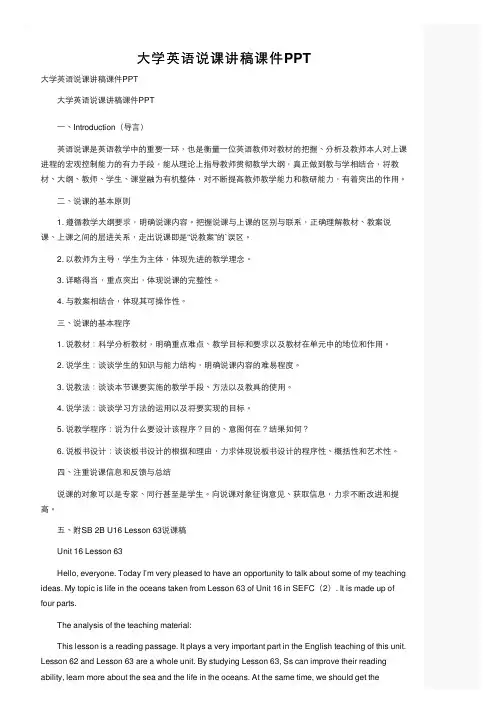
⼤学英语说课讲稿课件PPT⼤学英语说课讲稿课件PPT ⼤学英语说课讲稿课件PPT ⼀、Introduction(导⾔) 英语说课是英语教学中的重要⼀环,也是衡量⼀位英语教师对教材的把握、分析及教师本⼈对上课进程的宏观控制能⼒的有⼒⼿段,能从理论上指导教师贯彻教学⼤纲,真正做到教与学相结合,将教材、⼤纲、教师、学⽣、课堂融为有机整体,对不断提⾼教师教学能⼒和教研能⼒,有着突出的作⽤。
⼆、说课的基本原则 1. 遵循教学⼤纲要求,明确说课内容。
把握说课与上课的区别与联系,正确理解教材、教案说课、上课之间的层进关系,⾛出说课即是“说教案”的`误区。
2. 以教师为主导,学⽣为主体,体现先进的教学理念。
3. 详略得当,重点突出,体现说课的完整性。
4. 与教案相结合,体现其可操作性。
三、说课的基本程序 1. 说教材:科学分析教材,明确重点难点、教学⺫标和要求以及教材在单元中的地位和作⽤。
2. 说学⽣:谈谈学⽣的知识与能⼒结构,明确说课内容的难易程度。
3. 说教法:谈谈本节课要实施的教学⼿段、⽅法以及教具的使⽤。
4. 说学法:谈谈学习⽅法的运⽤以及将要实现的⺫标。
5. 说教学程序:说为什么要设计该程序?⺫的、意图何在?结果如何? 6. 说板书设计:谈谈板书设计的根据和理由,⼒求体现说板书设计的程序性、概括性和艺术性。
四、注重说课信息和反馈与总结 说课的对象可以是专家、同⾏甚⾄是学⽣。
向说课对象征询意⻅、获取信息,⼒求不断改进和提⾼。
五、附SB 2B U16 Lesson 63说课稿 Unit 16 Lesson 63 Hello, everyone. Today I’m very pleased to have an opportunity to talk about some of my teaching ideas. My topic is life in the oceans taken from Lesson 63 of Unit 16 in SEFC(2). It is made up of four parts. The analysis of the teaching material: This lesson is a reading passage. It plays a very important part in the English teaching of this unit. Lesson 62 and Lesson 63 are a whole unit. By studying Lesson 63, Ss can improve their reading ability, learn more about the sea and the life in the oceans. At the same time, we should get thestudents to understand some difficult sentences to comprehend the passage better. The Ss should do some listening, speaking and writing, too. Of course, the Ss should receive some moral education. Let the Ss understand the sea better, love the sea and save the sea and the life of the sea. Teaching aims: 1. Knowledge aim: Understand the main idea of the text. 2. Ability aim: Retell the text in their own words. 3. Emotional aim: Make the Ss love the life of the sea and do something to stop it being polluted. Key points / Teaching important points: How to understand the text better. Teaching difficult points: 1. Use your own words to retell the text. 2. Discuss the pollution of the sea and how to save the sea. Something about the Ss: 1. The Ss have known something about the sea and sea life through the Internet and other ways. 2. They are lack of vocabulary. 3. They don’t often use English to express themselves and communicate with others. 4. Some Ss are not active in the class because they are afraid of making mistakes. Before dealing with this lesson, I’ll do my best to carry out the following theories: Make the Ss the real masters in class while the teacher himself acts as director; Combine the language structures with the language functions; Let the students receive some moral education while they are learning the English language. Teaching method: Double activities teaching method Question-and-answer activity teaching method Watch-and-listen activity Free discussion method Pair work or individual work method Teaching aids: 1. a projector 2. a tape recorder 3. multimedia 4. the blackboard I have designed the following steps to train their ability of listening, speaking, reading and writing,especially reading ability. The entire steps are: Greetings, Revision, Lead-in and preparation for reading, Fast reading(scanning), Listening, Intensive reading, Preparation for details of the text, Consolidation, Discussion, Homework Step 1 Greetings Greet the whole class as usual. Step 2. Revision 1. Ask students some questions to revise the last lesson(show them on the screen).a. How much salt do the oceans contain per thousand parts of water?(35 parts of salt. 3.5% by weight)b. What is coral? Why are corals not found in deep water? c. Why is the Dead Sea called the Dead Sea? 2. Check the homework(made a survey about the sea or sea life by surfing the Internet or asking for help from other people). Through this part we can consolidate what they studied yesterday, communicate with others about their survery results and prepare for the new lesson. Step 3. Lead-in and preparation for reading Show them some pictures and let them talk each other, and then use the pictures about sea and life in the oceans to learn new words, for example, Antarctica, huge whale, sperm whale, squid and so on. Purpose: Arouse the students’ interest of study. Bring in new subject: Life in the oceans. Step 4. Fast reading Read the passage as quickly as they can. I show the questions on the screen and let them get the main idea of each paragraph: 1. Why can living things live in such oceans around the Antarctica? 2. What does the whale feed on? 3. What is the difference between the sperm whale and other whales? Method: Read the text individually, use question—and—answer activity. Purpose: Improve the students’ reading ability. Understand the general idea of each paragraph. Step 5. Listening(book closed) 1. Listen to the tape then do an exercise(wb page 90, part 1) 2. True or false exercise.(on the screen) Train the Ss’ listening ability and prepare for later exercises. Step 6. Intensive reading Read the passage carefully again and answer some detailed questions on the screen. 1. How much does a whale eat at a time? 2. Do all the whales feed on small fish? 3. How deep can a sperm whale dive? It is also called depth reading or study reading. It means reading for detailed information. Purpose: Further understand the text (Train further reading ability) to find out some different sentences and details of the text. Step 7. Preparation for details of the text on the screen 1. ...its heart slows to half its normal speed. slow-v. to become / make slower. 2. ing sound wave Present participle used as adverbial. 3. provide sth. for sb. provide sb. with sth. 4. at a time: each time 5. grow to a length of... Purpose: Train the Ss’ ability of understanding and using laguage. Step 8. Consolidation 1. Find out the topic sentences. 2. Retell the passage according to the topic sentences. Purpose: I want to know if my students understand the whole text really and if they master what I mean to tell them in this class. What’s more, I want to let them have the ability of introducing and analyzing expression. At the same time, I will write down the topic sentences on the blackboard according to what the students find, so they can retell it easily. Step 9. Discussion Show them some pictures about the polluted sea and many living things which are in danger and ask them: What are their opinions about it? In order to let them have free choice, I give them another topic: The sea is being polluted. What should they do? Purpose: I mean to give them emotional education. I give them multi-media pictures to arouse their interest of study and their love for life. I mean to make them realize: The sea is in danger! I teach them to do their best to help it and do something from now on. Everyone should do something to love and protect our home. Step 10. Homework Write an article Saving the sea. I want to improve the ability of their writing. At the same time, train the ability of do-it-yourself and looking up the information by themseleves. Unit 16 Lesson 63 Topic Sentences: 1. Some living things can live in Antarctica.(what) 2. The whale feeds on small fish.(what) 3. The sperm whale feeds on squid.(difference) Discussion: 1. The whales are in danger. What’s your opinion about it? 2. The sea is being polluted. What should we do? In my opinion, the blackboard design can reflect the teacher’s ability of mastering the text and leading the students to master the text easily. In this text, the design is not easy to write. I write the topic sentences on the blackboard in order to tell the students that this is of the importance in this class. The discussion is of the difficulty. I want to make the design inductive, instructive and artistic.。
大学英语说课课程设计一、课程目标知识目标:1. 学生能够掌握本节课所学的英语词汇和短语,并能在实际语境中正确运用。
2. 学生能够理解并运用本节课所学的语法知识,如时态、语态等,提高句子构建能力。
3. 学生能够听懂并参与课堂讨论,掌握一定的听力技巧。
技能目标:1. 学生能够运用所学知识进行口头表达,提高英语口语交流能力。
2. 学生能够通过小组合作,提高团队协作能力和解决问题的能力。
3. 学生能够通过课堂活动,提高自己的跨文化交际能力。
情感态度价值观目标:1. 学生对英语学习保持积极的态度,增强学习英语的兴趣和自信心。
2. 学生能够尊重并欣赏不同文化,培养跨文化交际意识。
3. 学生通过课堂讨论,培养批判性思维,形成独立思考的能力。
课程性质:本课程为大学英语说课,注重培养学生的英语口语表达能力,提高学生的英语实际应用能力。
学生特点:大学一年级学生,具备一定的英语基础,但对英语口语表达和实际应用仍有待提高。
教学要求:结合学生特点,注重启发式教学,采用多样化的教学手段,激发学生的学习兴趣,提高学生的英语综合素质。
将课程目标分解为具体的学习成果,以便进行后续的教学设计和评估。
二、教学内容本节课教学内容主要围绕《大学英语》教材第三单元“Campus Life”展开。
具体内容包括:1. 词汇和短语:学习并掌握与校园生活相关的词汇和短语,如:cafeteria、library、dormitory、extracurricular activities等。
2. 语法知识:复习并巩固一般现在时、一般过去时和一般将来时,学习并运用被动语态。
3. 听力训练:通过听力练习,提高学生对于英语口语的理解能力,尤其是关于校园生活的场景。
4. 口语表达:运用所学词汇、短语和语法知识,进行口语表达练习,如:自我介绍、描述校园生活、讨论兴趣爱好等。
5. 阅读理解:阅读教材中相关文章,提高阅读理解能力,了解不同国家的校园文化。
6. 小组讨论:分组讨论校园生活中的趣事,提高跨文化交际能力。
大学英语课程说课一、课程性质与地位大学英语是潍坊工商职业学院一门必修的公共基础课。
《大学英语》课程是面向高等职业教育非英语专业大学一年级学生,是在以教材为核心的基础上,以素质教育和学生的发展为根本宗旨,以外语教学理论为指导,以英语语言知识与应用技能、跨文化交际和学习策略为主要内容,以加强学生综合语言应用能力为目的的一门学科。
该课程融语言,文化和知识于一体,重视素质与能力培养,教学上突出交际性,强调听、说、读、写、译五项语言技能的综合训练,对促进课堂教学方法,教学手段和教学内容改革,培养基础扎实,知识面广的实用型人才具有积极意义。
大学英语作为我们学院必修的一门公共基础课,要一手抓“高等学校英语应用能力考试”强化训练,一手抓学生英语基本功的培养与训练,同时增强学生的自主学习能力,加强文化素养,培养既能做事(具备一定英语运用能力)又会做人的(具备良好职业道德和人文素养)的新时代大学生,使学科教学与各专业的人才培养目标相吻合。
二、课程目标2.1目标依据据教育部16号文所提出的高职教育培养目标:以服务为宗旨,以就业为导向,培养具有必要理论知识和较强实践能力,面向生产、建设、服务和管理第一线高素质技能型专门人才。
经过99学时的教学,使学生较好地掌握英语基础知识和技能,具有一定的听、说、读、写、译的能力,从而能借助词典阅读和翻译有关英语业务资料,在涉外交际的日常活动和业务活动中进行简单的口头和书面交流,并为今后继续提高英语交际能力打下基础,为专业人才培养服务。
2.2课程目标知识目标:掌握大纲所规定的词汇、习语搭配及重要句型结构;掌握动词的时态语态形式及用法;掌握非谓语动词的各种时态语态形式与用法;掌握名词性从句、定语从句、状语从句、倒装、强调、虚拟语气等语法知识;掌握各类应用文体的写作特点及相关的句型结构。
能力目标:培养学生较强的阅读能力和一定的听、说、读、写、译的能力,使他们能用英语交流信息,不断提高他们的语言综合运用能力,培养学生的自主学习能力。
10分钟大学英语说课稿范文8篇10分钟大学英语说课稿范文8篇说课稿是教师在备课时编写的一份文稿,用于向教研组、同事或评审者详细解释自己的教学设计和教学思路。
通常包含一份整体的教学设计,包括教学目标、教学内容、教学方法、教学过程等方面的详细说明。
现在随着小编一起往下看看10分钟大学英语说课稿范文,希望你喜欢。
10分钟大学英语说课稿范文精选篇1一、说教材(Textbook)在人教版高一英语的下册的Unit 19,曾经谈论过一些关于农业的话题,学生对中国早期的出名的农业家贾思勰有了一定的了解。
人教版高三英语的Unit 4这个单元以Green World 为话题,让学生初步了解一些植物学方面的内容,如植物的分类、栽培以及植物学的发展的历程等等;语言技能和很多的语言点几乎都是围绕介绍绿色世界这一中心话题而展开的。
要求学生能够运用所学的内容对相关话题进行流利的表述。
在READING部分,介绍了植物学正式成为一门科学的历史形成过程。
重点介绍了两个为植物学发展做出过卓越贡献的重要人物林厄尼斯与班克斯。
他们以独特的归类的方式对植物进行分类,从而征服了整个世界。
在POST-READING 部分,针对READING部分的相关内容设计了5个练习。
第1个练习以选择填空的形式考查学生对课文细节内容的了解。
第2-5小题以问句的形式进一步考查学生对课文重点内容的了解。
二、说教学目标(Teaching goals)1、让学生了解植物这一学科的形成,并了解一个学科的形成需要经过漫长的时间及几代的科学家的努力和奋斗。
2、使学生了解科学家为科学事业所作的努力及其奋斗精神。
3、培养学生查找细节,分析主题从而提高学生的阅读理解能力。
4、学习一些有用的词汇和短语。
5、加深对阅读技巧(Scanning and skimming method)的理解及运用。
1、Target language语言目标1)、Learn some important words and phrases(学习一些有用的词汇和短语)merely, classify, identification, male, promote, botanical, privilege, cosy, wealth, expense reward, appetite output, accumulate, abandon, dtinguh, appoint, calculate , astronomy, enterpre, settlement, abandon, on a large scale, look out for2)、Learn some important sentences(学习一些重要句子)A、Attempts had been made by others to classify plant species into groups, but the breakthrough came with the work of Carl Linnaeus、P30B、In 1768, the Royal Navy appointed James Cook as the commander of the Endeavor to take members of the Royal Society on an expedition to Tahiti、P31C、He also looked out for new economic species: plants that couldbe grown in England or other parts of the world to produce crops that could be sold、P31D、Banks was the first to move crops from one continent to another on a large scale, helping to develop local economies with these new imports、P312、Ability goals 能力目标Enable students to talk about “Botany” and say something aboutthe development htory of botany、Help the students to know the contribution of the three important persons to the science ofbotany、Try to improve the reading ability of the students、www、dakao8、com/三、Teaching important and difficult points说教学重点及教学难点Help students to understand the whole passage、Help students toknow how to use some key words and understand the meaning of some difficult sentences、四、说教学方法和学法指导Teaching methods and study guide在本单元的Reading当中,文章比较长,有很多有的新单词,个别的句子非常难理解,学生在阅读当中一定会遇到一定的困难。